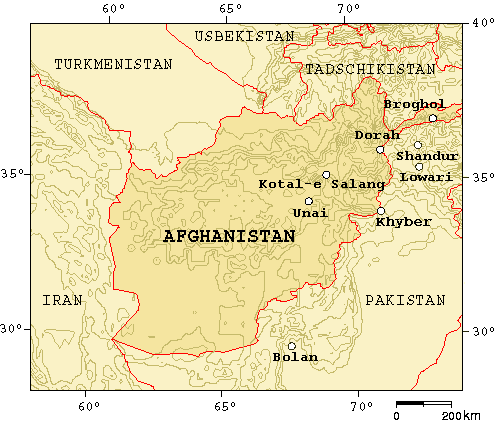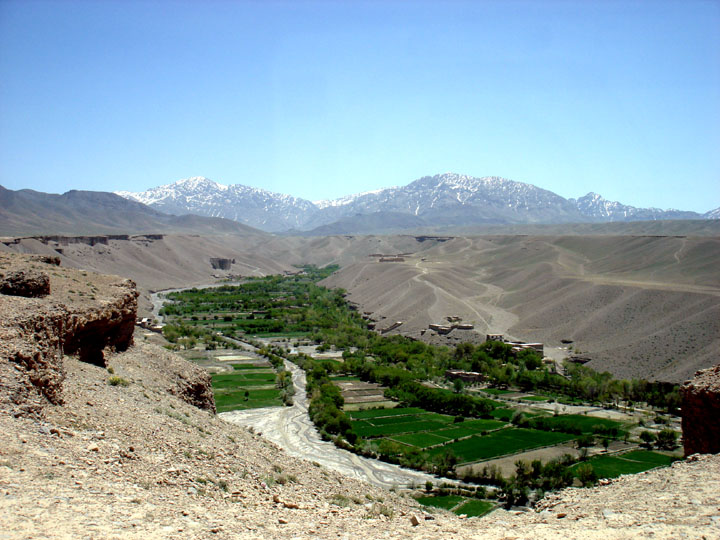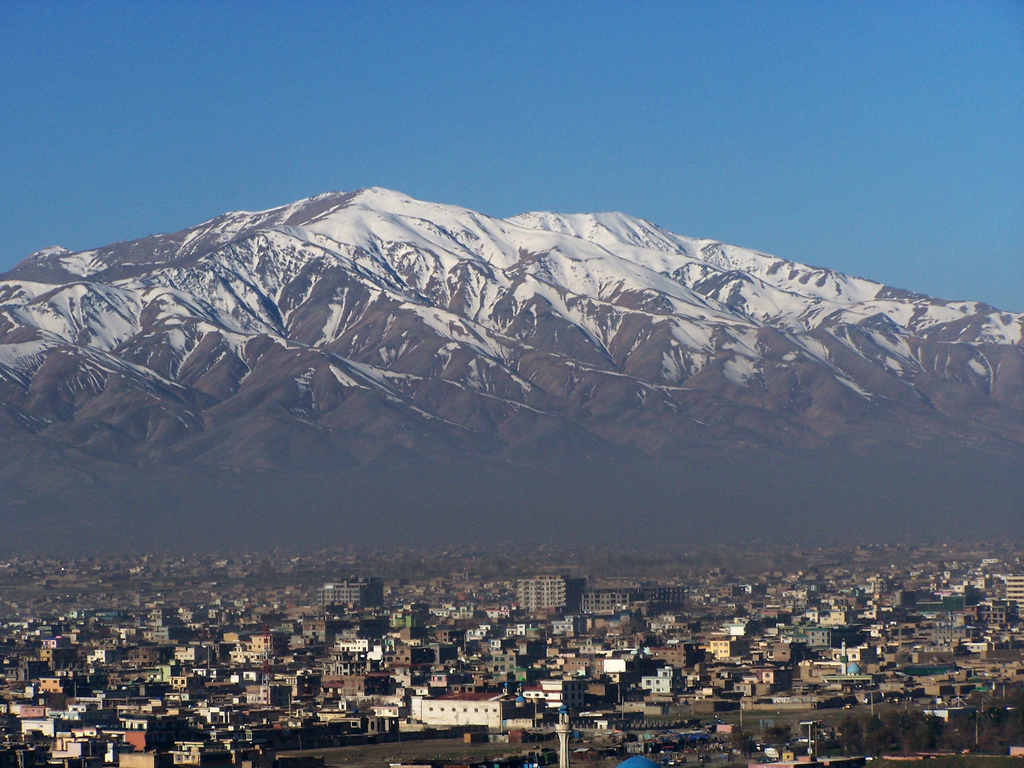|
Wardak Province
Maidan Wardak (Pashto: ; Dari: ), also called Wardag or Wardak, is one of the 34 provinces of Afghanistan, located in the central region of Afghanistan. It is divided into eight districts and has a population of approximately 500,00 The capital of the province is Maidan Shar, while the most populous district in the province is Saydabad District. Wardak is known for one of its famous high peak mountain known as (Shah Folad In 2021, the Taliban gained control of the province during the 2021 Taliban offensive. History During the communist times, the people of Wardak never gave significant support to the communist government. Wardak Province was significant during the Civil War in Afghanistan, due to its proximity with Kabul and its agricultural lands. Hezb-e Wahdat had a significant presence in the area. Most of the area was captured by the Taliban around winter 1995. It remains a major Taliban travel route to Kabul with Maidan Shar a target for terror. The security situ ... [...More Info...] [...Related Items...] OR: [Wikipedia] [Google] [Baidu] |
Provinces Of Afghanistan
Afghanistan is divided into 34 provinces (, '' wilåyat''). The provinces of Afghanistan are the primary administrative divisions. Each province encompasses a number of districts or usually over 1,000 villages. Provincial governors played a critical role in the reconstruction of the Afghan state following the creation of the new government under Hamid Karzai. According to international security scholar Dipali Mukhopadhyay, many of the provincial governors of the western-backed government were former warlords who were incorporated into the political system. Provinces of Afghanistan Regions of Afghanistan UN Regions Former provinces of Afghanistan During Afghanistan's history it had a number of provinces in it. It started out as just Kabul, Herat, Qandahar, and Balkh but the number of provinces increased and by 1880 the provinces consisted of Balkh, Herat, Qandahar, Ghazni, Jalalabad, and Kabul. * Southern Province – dissolved in 1964 to create Paktia Prov ... [...More Info...] [...Related Items...] OR: [Wikipedia] [Google] [Baidu] |
Kabul
Kabul (; ps, , ; , ) is the capital and largest city of Afghanistan. Located in the eastern half of the country, it is also a municipality, forming part of the Kabul Province; it is administratively divided into 22 municipal districts. According to late 2022 estimates, the population of Kabul was 13.5 million people. In contemporary times, the city has served as Afghanistan's political, cultural, and economical centre, and rapid urbanisation has made Kabul the 75th-largest city in the world and the country's primate city. The modern-day city of Kabul is located high up in a narrow valley between the Hindu Kush, and is bounded by the Kabul River. At an elevation of , it is one of the highest capital cities in the world. Kabul is said to be over 3,500 years old, mentioned since at least the time of the Achaemenid Persian Empire. Located at a crossroads in Asia—roughly halfway between Istanbul, Turkey, in the west and Hanoi, Vietnam, in the east—it is situated in a stra ... [...More Info...] [...Related Items...] OR: [Wikipedia] [Google] [Baidu] |
Unai Pass
The Unai Pass or Onai Pass is a mountain pass on the western side of the Paghman Mountains in Jalrez District, Maidan Wardak Province, Afghanistan. It is of strategical importance due to its geographical location to the southwest of Kabul Kabul (; ps, , ; , ) is the capital and largest city of Afghanistan. Located in the eastern half of the country, it is also a municipality, forming part of the Kabul Province; it is administratively divided into 22 municipal districts. Acco .... The Sarchashma River flows through the pass, which is the upstream part of the Kabul River. The Maidan River, a tributary of the Kabul/Sarchashma rises at the pass at an altitude of about . Due to its importance, the pass has a long history of being involved in conflict in Afghanistan. In 1929, Muhammad Mir Fath (1901-1964) was one of three Hazara commanders who defeated the forces of Habibullah Kalakani at the pass between March and September of that year. The '' mujahedin'' took the Unai P ... [...More Info...] [...Related Items...] OR: [Wikipedia] [Google] [Baidu] |
Kabul–Kandahar Highway
The Kabul–Kandahar Highway (NH0101) is a road linking Afghanistan's two largest cities, Kabul and Kandahar, passing through Maidan Shar, Saydabad, Ghazni, and Qalati Ghilji. This highway is a key portion of Afghanistan's national highway system or "National Highway 1". The entire highway from Kandahar to Kabul is on flat surface, with no mountain passes. Approximately 35 percent of Afghanistan's population lives within of the Kabul to Kandahar portion of the Ring Road. Overview The Kabul-Kandahar highway was in major disrepair due to over two decades of war and neglect. The United States funded the repair and rebuilding of of road (at a cost of about $190 million), while Japan funded . About of the highway were already usable prior to the repairs. The rebuilding project was overseen by the Louis Berger Group, with assistance in planning and design by Turkish and Indian engineers. Phase one of paving was completed in December 2003 and the highway was opened to traffic. Th ... [...More Info...] [...Related Items...] OR: [Wikipedia] [Google] [Baidu] |
Tangi Valley
Tangi Valley (also known as Wardak Valley or Tangi Wardak) is located in the south of Wardak Province in Afghanistan. Between 2009 and 2011 it was occupied by US forces, and became known for the large number of US troops killed there.{{{cite book , last1=Brereton , first1=Brian G. , date=2015 , title=Social Science Goes to War: The Human Terrain System in Iraq and Afghanistan , chapter-url=https://oxford.universitypressscholarship.com/view/10.1093/acprof:oso/9780190216726.001.0001/acprof-9780190216726-chapter-10 , publisher=Oxford University Press , chapter=10 , isbn=9780190216726 It was considered at important area and hence was a focus of insurgent activity due to its proximity to Kabul Kabul (; ps, , ; , ) is the capital and largest city of Afghanistan. Located in the eastern half of the country, it is also a municipality, forming part of the Kabul Province; it is administratively divided into 22 municipal districts. Acco ..., the capital of Afghanistan. The 2011 Chin ... [...More Info...] [...Related Items...] OR: [Wikipedia] [Google] [Baidu] |
Bamyan Province
Bamyan Province ( prs, ولایت بامیان) also spelled Bamiyan, Bāmīān or Bāmyān is one of the thirty-four provinces of Afghanistan, located in the central highlands of the Afghanistan. The terrain in Bamyan is mountainous or semi-mountainous, at the western end of the Hindu Kush mountains concurrent with the Himalayas. The province is divided into eight districts, with the town of Bamyan serving as its capital. The province has a population of about 495,557 and borders Samangan to the north, Baghlan, Parwan and Wardak to the east, Ghazni and Daykundi to the south, and Ghor and Sar-e Pol to the west. It is the largest province in the Hazarajat region of Afghanistan and is the cultural capital of the Hazara ethnic group that predominates in the area. It was a center of commerce and Buddhism in the 4th and 5th centuries. In antiquity, central Afghanistan was strategically placed to thrive from the Silk Road caravans that crisscrossed the region, trading betwe ... [...More Info...] [...Related Items...] OR: [Wikipedia] [Google] [Baidu] |
Ghazni Province
Ghazni (Dari: ) is one of the 34 provinces of Afghanistan, located in southeastern Afghanistan. The province contains 19 districts, encompassing over a thousand villages and roughly 1.3 million people, making it the 5th most populous province. The city of Ghazni serves as the capital. It lies on the important Kabul–Kandahar Highway, and has historically functioned as an important trade center. The Ghazni Airport is located next to the city of Ghazni and provides limited domestic flights to Afghanistan's capital, Kabul. Ghazni borders the provinces of Maidan Wardak, Logar, Paktia, Paktika, Zabul, Uruzgan, Daykundi and Bamyan. Etymology The province was known as Ghazna in the 10th century, during and after the Ghaznavid era. History Ghazni was a thriving Buddhist center before and during the 7th century AD. Excavations have revealed religious artifacts of both Hindu and Buddhist traditions. In 644 AD, the Chinese pilgrim Xuanzang visited the city of Jaguda (proba ... [...More Info...] [...Related Items...] OR: [Wikipedia] [Google] [Baidu] |
Logar Province
Logar (Pashto/Dari: ; meaning Greater Mountain ( لوې غر)) is one of the 34 provinces of Afghanistan located in the eastern section of the country. It is divided into 7 districts and contains hundreds of villages. Puli Alam is the capital of the province. As of 2021, Logar has a population of approximately 442,037. It is a multi-ethnic tribal society, while about 65% of its residents are made up by Pashtuns whereas the remainder are Tajiks and Hazaras. The Logar River enters the province through the west and leaves to the north. History Pre Islamic era A 2,600-year-old a Zoroastrian fire temple was found at Mes Aynak (about 25 miles or 40 kilometers southeast of Kabul). Several Buddhist stupas and more than 1,000 statues were also found. Smelting workshops, miners’ quarters (even then the site's copper was well known), a mint, two small forts, a citadel, and a stockpile of Kushan, Sassanian and Indo-Parthian coins were also found at the site. Recent history ... [...More Info...] [...Related Items...] OR: [Wikipedia] [Google] [Baidu] |
Kabul Province
Kabul (Persian: ), situated in the east of the country, is one of the thirty-four provinces of Afghanistan. The capital of the province is Kabul city, which is also Afghanistan's capital and largest city. The population of the Kabul Province is over 5 million people as of 2020, of which over 85 percent live in urban areas. The current governor of the province is Qari Baryal. It borders the provinces of Parwan to the north, Kapisa to the north-east, Laghman to the east, Nangarhar to the south-east, Logar to the south, and Wardak to the west. Geography Kabul is located between Latitude 34-31' North and Longitude 69-12' East at an altitude of 1800 m (6000 feet) above sea level, which makes it one of the world's highest capital cities. Kabul is strategically situated in a valley surrounded by high mountains at crossroads of north-south and east-west trade routes. One million years ago the Kabul region was surrounded from south-east between Lowgar and Paghman Mountains ... [...More Info...] [...Related Items...] OR: [Wikipedia] [Google] [Baidu] |
Parwan Province
Parwan (Dari: ), also spelled Parvan, is one of the 34 provinces of Afghanistan. It has a population of about 751,000. The province is multi-ethnic and mostly rural society. The province is divided into ten districts. The town of Imam Abu Hanifa serves as the provincial capital. The province is located north of Kabul Province and south of Baghlan Province, west of Panjshir Province and Kapisa Province, and east of Maidan Wardak Province and Bamyan Province. The province famous tourism attraction is the Golghondi Hill, also known as “the flower hill,” is located in Imam Azam city of the ancient Parwan province about an hour away from the capital city of KabuAfter Panjshir this province has been considered as one of the main raising points of Afghanistan War against Soviets. The name Parwan is also attributed to a town, the exact location of which is now unknown, that supposedly existed during prehistory, in the nearby Hindu Kush mountains. Frye, Richard Nelson (1999). "Fa ... [...More Info...] [...Related Items...] OR: [Wikipedia] [Google] [Baidu] |
Snow Storm DVIDS227328
Snow comprises individual ice crystals that grow while suspended in the atmosphere—usually within clouds—and then fall, accumulating on the ground where they undergo further changes. It consists of frozen crystalline water throughout its life cycle, starting when, under suitable conditions, the ice crystals form in the atmosphere, increase to millimeter size, precipitate and accumulate on surfaces, then metamorphose in place, and ultimately melt, slide or sublimate away. Snowstorms organize and develop by feeding on sources of atmospheric moisture and cold air. Snowflakes nucleate around particles in the atmosphere by attracting supercooled water droplets, which freeze in hexagonal-shaped crystals. Snowflakes take on a variety of shapes, basic among these are platelets, needles, columns and rime. As snow accumulates into a snowpack, it may blow into drifts. Over time, accumulated snow metamorphoses, by sintering, sublimation and freeze-thaw. Where the climate is c ... [...More Info...] [...Related Items...] OR: [Wikipedia] [Google] [Baidu] |










